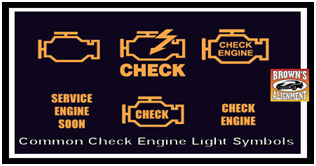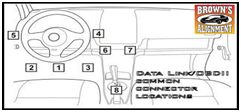
Check Engine Light
The check engine light, also known as the malfunction indicator light (MIL), serves as a warning signal that something is wrong. When your vehicle’s computer detects a problem with the engine or emissions system, it activates the check engine light to alert you. This indicator plays a crucial role in monitoring and maintaining compliance with environmental pollution guidelines set by the Environmental Protection Agency. Essentially, it’s your car’s way of saying, “Hey, something’s not right—better get it checked out!”
Visit the US Environmental Protection Agency (EPA) website for more information about vehicle emissions regulations and on-board diagnostics (OBD).
The maintenance required light is often mistaken for the check engine light, but unlike the MIL, this light doesn’t mean anything is wrong with your car. Click here to visit our page on maintenance lights.
CHECK ENGINE LIGHT SYSTEM
Cars use various diagnostic systems to pinpoint issues. Prior to 1996, each car manufacturer had its own on-board diagnostic system (OBD). However, from 1996 onward, manufacturers adopted a standardized approach known as OBDII. This system established guidelines for all manufacturers by defining a fixed list of diagnostic trouble codes (DTC) to be used. When the vehicle’s computer identifies a problem, it stores a trouble code in memory and triggers the check engine light to display on the dash.
Checking the Codes:
When the check engine light comes on, the computer stores a code or codes in memory. These codes provide valuable clues for our technician to follow during the diagnostic process. While these codes are crucial to the process, they can’t be completely relied upon for a diagnosis. Our technician begins by using a device called an OBD scan tool to get code information from the vehicle’s computer. While a scan tool can help to verify a problem in a certain system, it doesn’t always paint a complete diagnostic picture. There are definitely cases where the code or codes don’t tell the technician the whole story, and further tests are necessary to find the root cause of the problem.
- PO171/PO174 codes: These codes can be misinterpreted as an oxygen sensor issue but can also be due to a vacuum or evaporative system leak.
- PO440 code: This code means an evaporative emission control system malfunction has occurred and it can often only be properly diagnosed with a smoke test of the evaporative system. This test requires using a machine to inject smoke into the system to help the technician pinpoint the source of the leak.
- PO401: This code indicates an exhaust gas recirculation (EGR) flow problem, but it doesn’t necessarily mean that the EGR valve needs to be replaced. Instead, it may involve simply cleaning carbon from the valve or clearing the ports and passageways leading to the EGR valve.
DIAGNOSTIC TROUBLE CODES:
Common Check Engine Light Codes (DTCs)
PO100 – PO199 = Fuel and Air Metering / Oxygen Sensors
– PO100 – PO104 = (MAF) Mass Air Flow Sensor / Meter
– PO105 – PO109 = (MAP) Manifold Absolute Pressure Sensor
– PO111 – PO114 = Intake Air Temperature Sensor
– PO115 – P0119 & PO125 -PO126 = Coolant Temperature Sensor
– PO120 – PO124 = (TPS) Throttle Position Sensor
– PO128 = Thermostat
– PO130 – PO167 = Oxygen Sensor / Air Fuel Ratio Sensor (PO135, PO141, PO155, PO161)
– PO171 – PO174 = Lean Condition
– PO172 – PO175 = Rich Condition
PO200 – PO299 = Fuel and Air Metering / Injector Circuit
– PO200 – PO212, PO261 = Fuel Injector
– PO230 – PO233 = Fuel Pump
PO300 – PO399 = Misfire and Ignition System
– PO300 – PO312 = Engine Misfire (PO301, PO302, PO303, PO304, PO305, PO306, PO307, PO308)
– PO325 – PO334 = Knock Sensor
– PO335 – PO339 = Crankshaft Position Sensor
– PO340 – PO344 = Camshaft Position Sensor
– PO350 – PO362 = Ignition Coil
PO400 – PO400 Emissions Control Systems
– PO400 – PO408 = (EGR) Exhaust Gas Recirculation Valve (PO401)
– PO420 – PO434 = Catalytic Converter (PO430)
– PO440 – PO452 = Evaporative Emissions ( PO455)
– PO460 – PO464 = Fuel Level Sensor
– PO480 – PO485 = Cooling Fan
PO505 – PO507 = Idle Control System
P0600-P0699 = Computer Output Circuit
P0700-P0899 = Transmission
P2xxx Generic Power train Diagnostic Codes DTC
There are also B codes which are body codes and C codes which are chassis codes.
Data Link Connector
The OBDII system required all auto makers to install a universal plug that scan tools can connect to. This plug is called the Data Link Connector (DLC) and is usually found under the driver’s side of the dash. However, some manufacturers decided to be creative and install the connector elsewhere. Some Honda and Acura vehicles hid the DLC behind the ashtray. Some Volvos tucked the DLC away inside the center console, while some other manufacturers simply moved them to the other side and placed the DLC under the passenger side of the dash. When the check engine light is on, the technician connects a scan tool to the DLC to retrieve codes (DTCs) and can also get live data from various vehicle systems.

Common Data Link Connector Locations
Clearing the Check Engine Light
and Completing a Drive Cycle
Once the repairs are completed, the technician will use the scan tool to clear the codes from the vehicle’s computer. However, the car’s computer needs to undergo a “reset” process afterwards. This reset happens when the car goes through a specific drive sequence or cycle. The drive cycle varies from car to car, but generally involves a combination of idling, starts, stops, and driving at different speeds for varying durations. The use of heating or air conditioning may also be part of some drive cycles. Completing this drive cycle prompts the vehicle to activate its on-board diagnostics and reset its readiness monitors.
Emissions readiness monitors, also known as OBD (On-Board Diagnostics) readiness monitors, are systems within a vehicle’s engine control module (ECM) or onboard computer that monitor the performance of various emission-related components. These monitors check if the emissions control system is functioning properly and if the vehicle is compliant with environmental standards. This step is crucial for the vehicle to be “ready” for a state inspection. Manufacturers recommend following the drive cycle as the proper method to reset the computer.
While attempting the cycle in traffic can be challenging and impractical, most vehicles will naturally reset themselves with regular around-town driving, typically within 50 to 100 miles.
Why does the check engine light blink or flash?
If specific conditions are met, the check engine light may start blinking or flashing. This signals a significant engine misfire. In such instances, it’s crucial for the driver to slow down as soon as safely possible and arrange for service. Sustained engine misfires, even over a brief period, can cause serious harm to emission control system components, with the catalytic converter being particularly susceptible to damage and often costly to replace. It’s advisable for drivers to refer to their vehicle owner’s manual for manufacturer-specific details.
